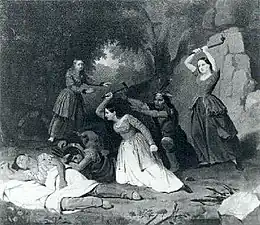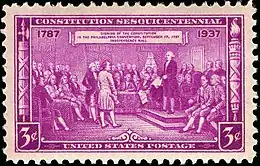Junius Brutus Stearns
Junius Brutus Stearns (born Lucius Sawyer Stearns, June 2, 1810 – September 17, 1885) was an American painter best known for his five-part Washington Series (1847–1856).[1]


He was a member of the National Academy of Design for several decades and a member of its council.
He was born Lucius Sawyer Stearns[1] in Arlington, Vermont. He named two sons after him, one Lucius Stearns, and the other Junius Brutus Stearns, Jr. Stearns, Jr., served in the Civil War in the 44th Regiment.[2] JB Stearns served in the Civil War as well, in New York's 12th Regiment.[3][4] He also had two other sons, Raphael and Michaelangelo, and a daughter, Edith Sylvia.[5]
His painting The Millennium was submitted as credentials for his admission as a member of the National Academy of Design.[6]
Death
He died September 17, 1885, in Brooklyn, New York, in a horse-and-carriage accident after returning from a night at the theatre.[7] He was 75 years old and was interred at Cypress Hills Cemetery in Brooklyn.[8]
Paintings

Stearns is most famous for his series on George Washington.[9] Of these his painting, Washington as a Statesman,[1] depicts President Washington addressing the Constitutional Convention; it is the subject of a US Postage Stamp in 1937.[10]
Stearns also painted a second series of Washington in which he depicted free blacks.[11] Not as much is known about this series or the intentions of the artist in so portraying blacks on the eve of the Civil War, although there was supposition by Mack, et al.[12]
Stearns' painting, Hannah Duston Killing the Indians (1847)[13] depicts the killing by Hannah Duston of Indians who had captured her and murdered her newborn daughter in 1697.[14] In the painting Stearns, for reasons that remain unclear, depicts Samuel Lennardson (Duston's fellow captive) as a woman. The six Indian children Duston killed are omitted. A second painting, showing Hannah's husband fleeing with her children, is now lost.[15]
References
- "Washington as Statesman at the Constitutional Convention by Junius Brutus Stearns - Teaching American History". teachingamericanhistory.org. Retrieved 26 April 2015.
- The Battles Before Richmond - Lists of Wounded in the Different Encounters. Names of the Prisoners in Richmond. Second Maine Regiment. Twenty-Second Massachusetts Regiment. TW...
- Wagenen, Avis Stearns Van (1901). "Stearns Genealogy and Memoirs". google.com. Retrieved 26 April 2015.
- History and honorary roll of the Twelfth Regiment, Infantry, N.G.S.N.Y. ISBN 9781432808761. Retrieved 26 April 2015.
- "RootsWeb: PETIT-L Edith (Stearns) Foy-Pettit and stepson Wade C. Pettit". rootsweb.com. Retrieved 26 April 2015.; "Catalogue of the Loan Exhibition of Historical Portraits and Relics ..." google.com. 1889. Retrieved 26 April 2015.
- Gail E. Husch (2000). Something Coming: Apocalyptic Expectation and Mid-Nineteenth-Century American Painting.
- New York Times (09.19.1885)
- "Notable Burials". Cypress Hills Cemetery. Retrieved 2022-02-07.
- Thistlewaite, Mark Edward (1979). The Image of George ashington: Studies in Mid-Nineteenth-Century American History Painting. New York: Garland.
- SESQUICENTENNIAL OF CONSTITUTION COMMEMORATIVE POSTAGE STAMP ISSUE OF 1937.
- JUNIUS BRUTUS STEARNS 1810
- Mack, Angela D.; Hoffius, Stephen G. (2008). Landscape of Slavery: The Plantation in American Art: Angela D. Mack, Stephen G. Hoffius, Todd D. Smith: 9781570037207: Amazon.com: Books. ISBN 978-1570037207.
- Painting by Junius Brutus Stearns, "Hannah Dustin Killing the Indians," 1847
- Barbara Cutter, "The Female Indian Killer Memorialized: Hannah Duston and the Nineteenth–Century Feminization of American Violence," Journal of Women's History, vol. 20, no. 2, 2008; pp 10–33
- Lauren Lessing, "Theatrical Mayhem in Junius Brutus Stearns's Hannah Duston Killing the Indians," American Art, Volume 28, Issue 3, pp. 76-103
External links
- Junius Brutus Stearns at ArtCyclopedia